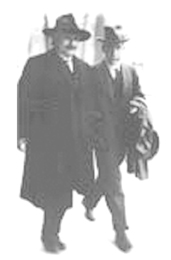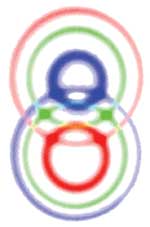Einstein and the EPR Paradox
 Einstein and Bohr |
By the 1920s, it had become clear to most physicists that classical mechanics could not fully describe the world of atoms, especially the notion of “quanta” first proposed by Planck and further developed by Albert Einstein to explain the photoelectric effect. Physics had to be rebuilt, leading to the emergence of quantum theory.
Werner Heisenberg, Niels Bohr and others who helped create the theory insisted that there was no meaningful way in which to discuss certain details of an atom’s behavior: for example, one could never predict the precise moment when an atom would emit a quantum of light. But Einstein could never fully accept this innate uncertainty, once famously declaring, “God does not play dice.” He wasn’t alone in his discomfort: Erwin Schrödinger, inventor of the wave function, once declared of quantum mechanics, “I don’t like it, and I’m sorry I ever had anything to do with it.”
In a 1935 paper, Einstein, Boris Podolsky and Nathan Rosen introduced a thought experiment to argue that quantum mechanics was not a complete physical theory. Known today as the “EPR paradox,” the thought experiment was meant to demonstrate the innate conceptual difficulties of quantum theory. It said that the result of a measurement on one particle of an entangled quantum system can have an instantaneous effect on another particle, regardless of the distance of the two parts.
One of the principal features of quantum mechanics is the notion of uncertainty: not all the classical physical observable properties of a system can be simultaneously determined with exact precision, even in principle. Instead, there may be several sets of observable properties–position and momentum, for example–that cannot both be known at the same time. Another peculiar property of quantum mechanics is entanglement: if two photons, for example, become entangled –that is, they are allowed to interact initially so that they will subsequently be defined by a single wave function–then once they are separated, they will still share a wave function. So measuring one will determine the state of the other: for example, with a spin-zero entagled state, if one particle is measured to be in a spin-up state, the other is instantly forced to be in a spin-down state.
 |
This is known as “nonlocal behavior;” Einstein dubbed it “spooky action at a distance.” It appears to violate one of the central tenets of relativity: information can’t be transmitted faster than the speed of light, because this would violate causality.
It’s worth noting that Einstein wasn’t attempting to disprove quantum mechanics; he acknowledged that it could, indeed, predict the outcomes of various experiments. He was merely troubled by the philosophical interpretations of the theory, and argued that, because of the EPR paradox, quantum mechanics could not be considered a complete theory of nature. Einstein postulated the existence of hidden variables: as yet unknown local properties of the system which should account for the discrepancy, so that no instantaneous spooky action would be necessary. Bohr disagreed vehemently with this view and defended the far stricter Copenhagen interpretation of quantum mechanics. The two men often argued passionately about the subject, especially at the Solvay Conferences of 1927 and 1930; neither ever conceded defeat.
There have been numerous theoretical and experimental developments since Einstein and his colleagues published their original EPR paper, and most physicists today regard the so-called “paradox” more as an illustration of how quantum mechanics violates classical physics, rather than as evidence that quantum theory itself is fundamentally flawed, as Einstein had originally intended.
But the paper did help deepen our understanding of quantum mechanics by exposing the fundamentally non-classical characteristics of the measurement process. Before that paper, most physicists viewed a measurement as a physical disturbance inflicted directly on the measured system: one shines light onto an electron to determine its position, but this disturbs the electron and produces uncertainties. The EPR paradox shows that a “measurement” can be performed on a particle without disturbing it directly, by performing a measurement on a distant entangled particle.
Today, quantum entanglement forms the basis of several cutting-edge technologies. In quantum cryptography, entangled particles are used to transmit signals that cannot be intercepted by an eavesdropper without leaving a trace. The first viable quantum cryptography systems are already being used by several banks. And the burgeoning field of quantum computation uses entangled quantum states to perform computational calculations in parallel, so that some types of calculations can be done much more quickly than could ever be possible using classical computers.
©1995 - 2024, AMERICAN PHYSICAL SOCIETY
APS encourages the redistribution of the materials included in this newspaper provided that attribution to the source is noted and the materials are not truncated or changed.
Associate Editor: Jennifer Ouellette
Staff Writer: Ernie Tretkoff
November 2005 (Volume 14, Number 10)
Articles in this Issue

